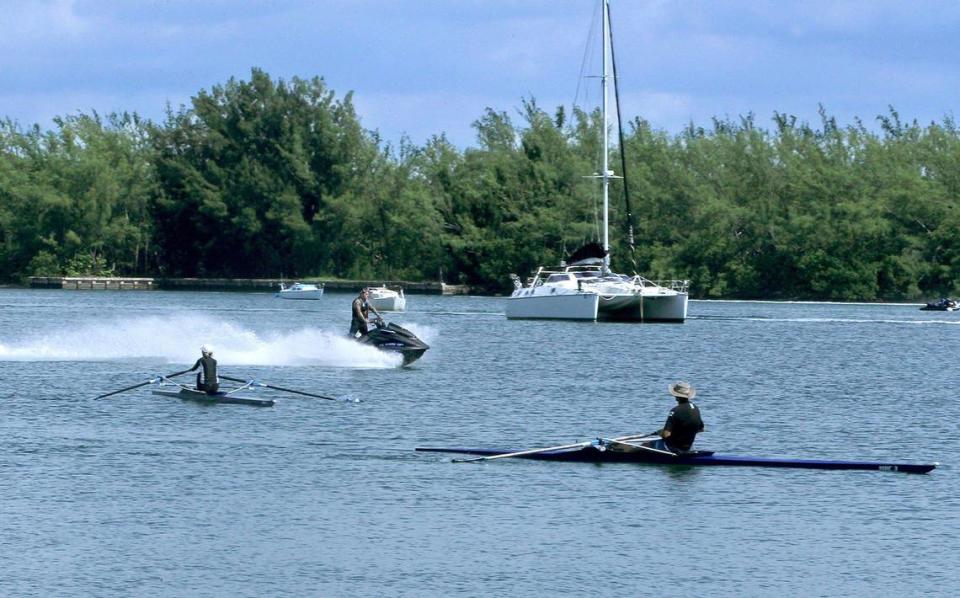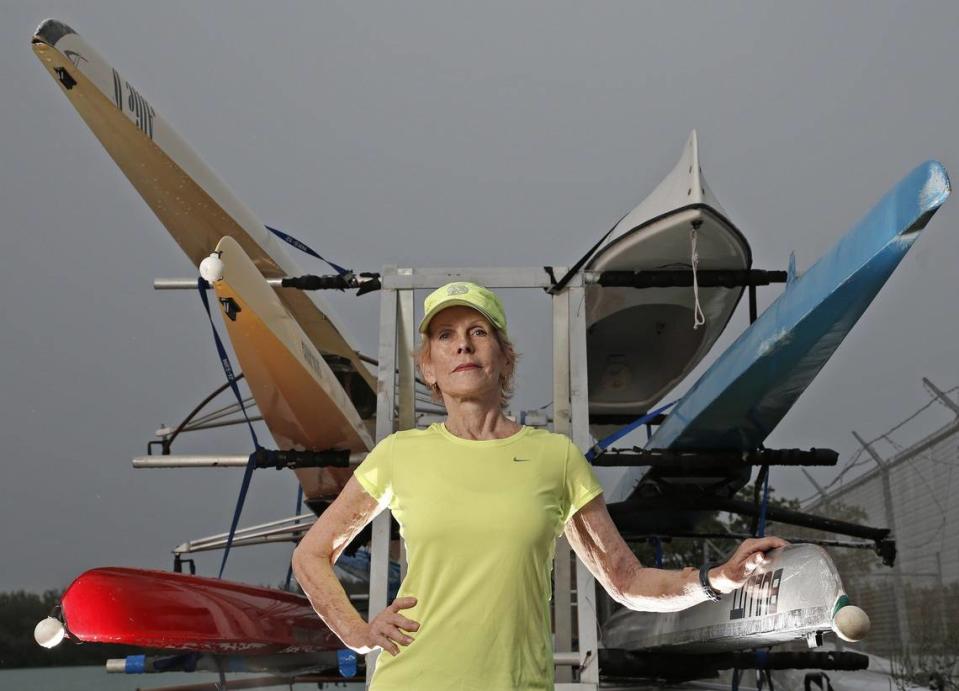Proposed Miami boat ramp pits paddlers against boaters in protected basin
The city of Miami’s efforts to reap green revenue from blue waters has incensed the protectors and paddlers of Virginia Key, who say a planned launching ramp for motorboats and water bikes will compound the hazardous chaos befouling the Marine Stadium basin.
Opponents of the boat ramp call it a “stealth project” that has been reincarnated without proper public notice despite the fact that it is prohibited by the city’s own Virginia Key Master Plan.
The ramp would be built on the west side of the derelict stadium and would be accompanied by a parking lot for 77 boat trailers on property already designated to become a public park.
It’s a piece of a larger plan by the city’s Department of Real Estate and Asset Management (DREAM) to increase revenue at marinas and on the waterfront by charging higher fees for docking and mooring boats. A DREAM analysis presented to commissioners on Thursday calculated a potential $13 million increase citywide in annual revenue by hiking rates and increasing capacity.
While the ramp would help satisfy high demand for access to the water by powerboat owners — weekend waiting lines are long at ramps and marinas — the formerly placid Marine Stadium basin is the last place the city should choose, say members of the Virginia Key Advisory Board and Virginia Key Alliance, advocates for the island located between the mainland and Key Biscayne.

“A boat ramp does not belong there,” said Vinson Richter, an advisory board member and a boater himself. “Boat ramps are not a pretty sight. Each one is a circus. You’ve got people maneuvering their trailers, arguing, showing no courtesy to each other, causing mishaps, discharging pollutants.”
The basin, a man-made lagoon, is the flatwater headquarters for the Miami Rowing Club, dragon boats and outrigger canoes and a haven for paddleboarders and kayakers. Triathlons start and finish there.
But it has become a crowded playground for loud party boats and a race track for often reckless operators of water bikes, popularly known by the Kawasaki brand name as jet skis. A 26-year-old water biker died May 1 near the basin when he was struck and killed by the hit-and-run driver of a 37-foot motorboat with nine passengers who was later arrested, pleaded not guilty and released on bond. It was at least the third personal watercraft death in the past year in an area where accidents are common. In another fatal case, a jet skier rammed into the Marine Stadium.
Harmonious coexistence isn’t happening. Rowers and paddlers complain they are swamped or capsized by the wakes generated by motorized craft. They fear collisions with inexperienced, inconsiderate or intoxicated water bike and powerboat drivers. Rowing club and school practices are regularly interrupted or called off because of speeding boats invading their space. Tempers flare, curses fly. Boaters have been accused of brandishing guns and selling alcohol and drugs.
“You’re flipped and it’s scary because you could be run over,” said rower Joyce Landry, co-founder of the Virginia Key Alliance. “They’re aggressive. They’re drunk. They toy with us.
“They have the entire bay and more while we have this one beautiful, protected place for non-motorized recreation.”
Potential traffic tie-ups on causeway
The ramp could create a traffic nightmare on the Rickenbacker Causeway as vehicles towing boats turn left into the Marine Stadium parking lot on a road popular with cyclists, runners, walkers and beachgoers.
As a magnet for motorboats and water bikes, the ramp would be harmful to the environment of the lagoon, which is partially enclosed by a nature preserve. More boat traffic could further damage sea grass and endanger dolphins, manatees, stingrays and other marine life.
Motorboats anchor in the eastern end of the lagoon, blare music and leave litter behind. Rowing club members do regular trash cleanups and recently collected 3,000 pounds of beer cans, liquor bottles, food containers, plastic and a five-pound package of cocaine, Landry said.
“A boat ramp and hideous parking lot will only pose more danger to rowers and paddlers in the basin and cyclists and pedestrians on the causeway,” said Sunny McLean, a rower and co-founder of the Alliance. “It makes absolutely no sense in that location.”

A congested boat ramp would not be compatible with renovation plans for the 90-acre Marine Stadium and parking lot, which was used to stage the Miami International Boat Show before it decided to move to Miami Beach. The massive slab of pavement is covered with skid marks; drivers sneak in at night to drag race and spin “doughnuts” with their cars.
Plans for concert venue —‘our Tanglewood’
The city has hired a planning firm to reinvent the lot into a park that would complement the stadium, which has been closed, fenced off and covered with graffiti since Hurricane Andrew damaged it in 1992. The stadium, a 1963 Modernist landmark on the National Register of Historic Places, is slated for a $45 million revival as a concert and event venue.
“We have this unusual architectural gem on one of the most spectacular pieces of property in the country with 360-degree views of the water and the downtown skyline,” Vinson said. “It’s a unique venue like Red Rocks or the Hollywood Bowl. It’s our Tanglewood. Too often, the city does not appreciate what it has and ruins the potential of its beautiful places.”
For a sampling of what transpires at boat ramps watch the Miami Boat Ramps YouTube channel, which features “the greatest show on earth” — a comedy of errors of boaters hitting docks, bumping into each other, yelling at each other, falling into the water and clumsily struggling to get their vessels off and onto trailers.
“Boaters will launch, anchor in the basin and drink beer. Jet skis will add to the havoc,” Richter said. “Why is the city designing a $100-million venue and park project and plunking a boat ramp and trailer lot in the middle of it?”
At the April 27 Virginia Key Advisory Board meeting, more than 50 people spoke and 400 comments were submitted in opposition to the ramp.

“I see their concern with an increased level of intensity that could be hazardous in terms of safety and to the ecology of the natural area,” Miami Commissioner Ken Russell said. “With Crandon Marina basically across the street, I don’t know if we need another ramp that would be streaming vehicle traffic into the parking lot and boat traffic into the basin.”
But the city seems determined to build a ramp at that spot, even though it’s not allowed under the 2010 Master Plan and a proposal to add one and a mooring field was scrapped in 2018.
Short-cut city process, critics say
The city wants to use a $1 million Florida Inland Navigation District grant to pay for the ramp, DREAM Senior Project Representative Andrew Schimmel said at the advisory board meeting. He said permits were issued after the project was presented at four previous city commission meetings with no outcry from the public.
But the ramp proposal was reintroduced last year as grant application and consent agenda items that the public was not aware of, Richter said. He asserted that the city described it as a renovation to an existing ramp in order to skirt the usual approval process even though a ramp never existed in that spot. What is there now is a piece of asphalt that the Boat Show poured to use for installing its floating docks.
“Every time we’ve told the city it’s a horrible idea and we think we’ve killed it, as is the case with so many horrible ideas by the city, it comes back like a bad penny,” Richter said. “They didn’t advertise this project or elicit public input to discuss the pros and cons. It’s a short cut. We feel we’ve been tricked -- ‘Here’s what we’ve decided, so you citizens, just go home.’
“It’s a sacred space that over time has also become a natural habitat. During the COVID pandemic boaters and jet skiers discovered it and took over.”
The Alliance described it as “a rogue project that has continued to live on in stealth mode” in emails to city officials asking for construction plans to be halted.
“Where’s the traffic study? The environmental study? What do the residents of Key Biscayne think about this?” said Landry, the co-founder of the alliance.
Alliance, advisory board and rowing club members say the city’s No. 1 priority for the 300-yard-wide and mile-long basin should be implementing a No Wake Zone, enabling Marine Patrol officers to crack down on irresponsible boat operators. Commissioners passed a law in 2014 creating a No Wake Zone but it was never implemented.
“Somehow the process through state authorities was never completed,” said Russell, whose district encompasses much of Miami’s waterfront. “Let’s get the signs up and push for enforcement and ticketing to get things under control.”
The city also wants to build a 97-boat mooring field that would stretch the length of the basin.
Virginia Key activists say it’s another bad money-making idea that ought to be scaled back.
“I think 40-45 mooring balls with designated, protected rowing lanes would be more appropriate to leave more room for nonmotorized users,” Russell said. “Right now, the mooring is random, there’s no required controlled pump-out of sewage and there are derelict boats in there. But I don’t want the basin to be overwhelmed with large boats.”
Former Mayor Manny Diaz declared that Virginia Key should be Miami’s Central Park. But the conflict between users and development forces never seems to end.
“Trying to preserve Virginia Key is like playing whack-a-mole,” Landry said. “We have a master plan but it seems to be merely a suggestion, so we are constantly fighting off schemes that are a slap in the face to what the people who love the key really want here.”


 Yahoo Movies
Yahoo Movies 